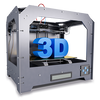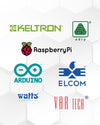DC Motor Starter Guide using Arduino Uno Board
Whenever a DC MOTOR starts, it poses unique challenges. The primary issue being the requirement of a starting current that is 5 to 6 times the load current. Such huge starting current can be damaging as it overheats the motor’s armature winding and results in a sudden voltage drop in the power supply.
Thus, it is essential to lower this starting current and a starter does exactly the same. It safeguards the motor’s circuit by working like a variable resistance in series with the armature circuit. In addition, it also reduces the load and torque of a motor when it starts. There are different types of starters namely 3 point starter, 4 point starter, no-load release coil starter, etc.
Described here is a DC motor starter using Arduino Uno board. The circuit uses pulse-width modulation (PWM) to control soft-start and soft-stop timings.
Why Arduino?
Conceptualised at the Ivrea Interaction Design Institute, Arduino projects in Cochin are gaining a lot of traction. All this can be attributed to the fact that Arduino is easy-to-use for beginners, yet flexible for advanced users when it comes to projects related to robotics, programming, building interactive prototypes among others.
Circuit
Below shown is the circuit diagram of the DC motor starter.

Components Used
- Arduino Uno board (Board1)
- PIC817 optocoupler (IC1)
- P-channel IRF9530 MOSFET (T1)
- 1N4007 rectifier diode (D1)
- 12V DC motor (M1)
- Bi-color LED (LED1)
- Pushbuttons (S1 and S2)
- Resistors( R1, R2, R3, R4,R5)
Working
Arduino Uno board is a vital component of the circuit and it generates PWM signals. The 12V DC motor is used for testing, LED 1 and some other components. Push buttons S1&S2 are used to soft-start and soft-stop the motor respectively. The bi-colour LED is used to indicate whether the mode motor i.e. soft-start or soft-stop.
Soft-start
- The circuit is switched on, motor is in rest mode and LED1 is off.
- Push button S1 is pressed for a moment and the voltage across the motor increases steadily.
- After the predetermined soft-start timing, the motor attains maximum voltage
- When the motor starts at a slow speed-LED1 emits green light.
- Once the motor starts running at the rated speed after soft-start time lapses-LED1 emits orange light
Soft-start
- The circuit is switched on, motor is in rest mode and LED1 is off.
- Push button S1 is pressed for a moment and the voltage across the motor increases steadily.
- After the predetermined soft-start timing, the motor attains maximum voltage
- When the motor starts at a slow speed-LED1 emits green light.
- Once the motor starts running at the rated speed after soft-start time lapses-LED1 emits orange light
Soft-stop
- While the motor is running at the rated speed, the pushbutton S2 is pressed momentarily and the motor’s pace decreases gradually.
- The speed decreases steadily and it stops after the soft-stop time lapses- LED1 emits red light
- Once the motor stops - LED1 doesn’t emit any light
Other components
- If switch S1 or S2 is pressed more than once before the soft-start or soft-stop timing ends, the Arduino Uno board executes only once. This prevents sudden restart of the motor.
- PIC817 optocoupler (IC1) is used to isolate the circuit in case of any disturbance in the motor power supply.
- Free-wheeling diode D1 is used to provide added protection from the induced voltage produced when the motor is turned off
- A software program (softs.ino) written in Arduino programming language sketch is loaded into the internal memory of Arduino Uno board, which is used to control the operations of the circuit.
- In order to compile and upload the program to the Arduino Uno board, Arduino IDE is used.
Construction and Testing
- Fig.2 shows the PCB layout of the DC motor soft-starter whereas Fig.3 shows the components of the same.
- Assemble the circuit on the PCB and use the external male-to-male jumper wires connect CON2 to Arduino Uno board.
- Upload the program to Board1
- The circuit works on the 5V USB power supply
- To operate the DC motor use regulated 12V power supply

Fig.2 : PCB layout of the DC motor starter using Arduino Uno

Fig. 3: Components layout for the PCB
Further application
Use thyristors instead of MOSFET T1 to convert the circuit into an AC motor soft-starter. You can use it along with device control projects. In fact, there are plenty of DIY Arduino Project applications popular in Cochin.
Different timings, PWM values for both soft-start and soft-stop, additional protection, closed-loop control can be incorporated in the circuit.



